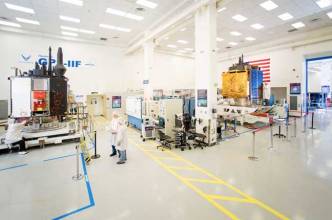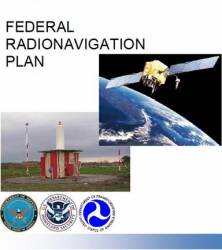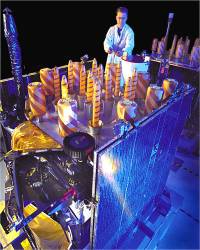The nation’s top GPS experts pressed the Air Force this week to turn on the full capability of the L2C civil GPS signal that the military has been broadcasting without a navigation message despite having had signal-equipped satellites on orbit for years.
The nation’s top GPS experts pressed the Air Force this week to turn on the full capability of the L2C civil GPS signal that the military has been broadcasting without a navigation message despite having had signal-equipped satellites on orbit for years.
Members of the National Space-Based Positioning, Navigation, and Timing (PNT) Advisory Board urged the Air Force Space Command (AFSPC) director of requirements, Major General Martin Whelan, to push to get the navigation message added to the signal. The signal has been broadcast since 2010 but, like a broadcast from an off-the-air radio station, does not contain the location and timing information needed to be fully useful.
“This has been an extremely long gestation time for this signal,” said board vice chair, Brad Parkinson during a meeting of the board on August 14.
L2C would be an “enormously more robust signal for precision operations that require two frequencies,” Parkinson said, perhaps causing manufacturers to hold back on incorporating the signal into their GPS receiver equipment. “Frankly, I think the manufacturers are hesitating because they are not certain what you are going to do. And I think that does a disservice to everybody because the lead times are so long.”
Seven IIR(M) and two IIF satellites are already in orbit capable of broadcasting the signal. The satellites are aging, however. The first of the series was launched in September 2005 and is now halfway through its design life.
Whelan acknowledged the delays. “The slide deck I was originally given to brief said that we would have that on in 12–18 months and, as I read backwards in time, I think we’ve been saying that since about 1998. I am not foolish enough to come up and give the same message.”
OCX Delay Suggested as Cause
Both military and civilian sources have told Inside GNSS that the main reason given for why the signal has not been fully activated is that the next-generation Operational Control Segment or OCX has yet to be completed. OCX, which is necessary for monitoring the signal, is behind schedule by some two years after a delay in the start of the contract.
Users may not fully understand the ramifications of using an unmonitored signal, said one source, who suggested officials were unlikely to go ahead without OCX in place and risk the fallout that would ensue if an accident occurred from use of L2C.
Parkinson argued, however, that a lack of monitoring should not be a show stopper. “I would urge you to let that go,” he told Whelan during the meeting, adding that users would understand that they would be using the signal at their own risk.
Money may be a factor in the delay, suggested GPS expert Kirk Lewis of the Institute for Defense Analyses. “There are some that feel that the civil community should have paid some fee to make this happen,” Lewis said.
“If I understand what you just said,” responded one of the board members, “they said, ‘Well, we’ll turn it on, but we would like to see your money first.’”
“From the Air Force Space Command perspective, I don’t think the economic argument is one that General (William) Shelton is tied up in,” said Whelan, referring to the AFSPC commander.
Whelan pointed out, however, that turning on the full signal would come with a price tag.
“There is a manual process that we’re pushing to bring online. It won’t be as timely as the automated process that OCX would deliver,” said Whelan. The process involves “a man-hour cost on the (operations) floor . . . that we are wrestling with,” he said.
“Where is the resistance to turning on the signal,” asked board chairman Jim R. Schlesinger, of MITRE and Barclays Capital. “We’ve paid for the capability, and we don’t make use of it.”
“The commander of Air Force Space Command has tasked [Maj. Gen. Jack Weinstein, Air Force Space Command’s director of Air, Space and Cyberspace Operations] to turn it on,” said Whelan. “The work he’s done in the last month, my assessment —I’ll caveat it that way — is that the resistance is really with our program office. How much money they spend on the tools needed for the ops floor versus how much money that they are spending on other modernization efforts that they are bringing forward. . . . General Weinstein has calibrated them properly; so, they’ll put the emphasis here.”
Whelan pledged to get the board a “better answer.”
“From a command perspective there’s no resistance,” he said, “but I’ll tell you, after my little walk through history, which most of you guys have lived, there is something out there, because it [turning on L2C has] always been 12 to 18 months away.”






